Physical Address
304 North Cardinal St.
Dorchester Center, MA 02124
This chapter will discuss how to assess heart size, then describe the normal and abnormal contours of the heart on the frontal radiograph and, finally, illustrate some imaging findings in common cardiac diseases.
The cardiac silhouette (“heart shadow”) can appear enlarged on conventional radiographs for three main reasons (arranged in the order in which they will be discussed, not by frequency of occurrence):
Pericardial effusion, which can mimic the appearance of cardiomegaly on conventional radiographs.
Extracardiac factors that produce apparent cardiac enlargement.
And most importantly, true cardiac enlargement (cardiomegaly ).
There are normally 15 to 50 cc of fluid in the pericardial space between the parietal and visceral pericardial layers. Abnormal accumulations of fluid begin in the dependent portions of the pericardial space that, in the supine position, is posterior to the left ventricle ( Fig. 11.1A ). As the pericardial effusion increases in size, it tends to accumulate more along the right heart border until it fills the pericardial space and encircles the heart ( Fig. 11.1B ).
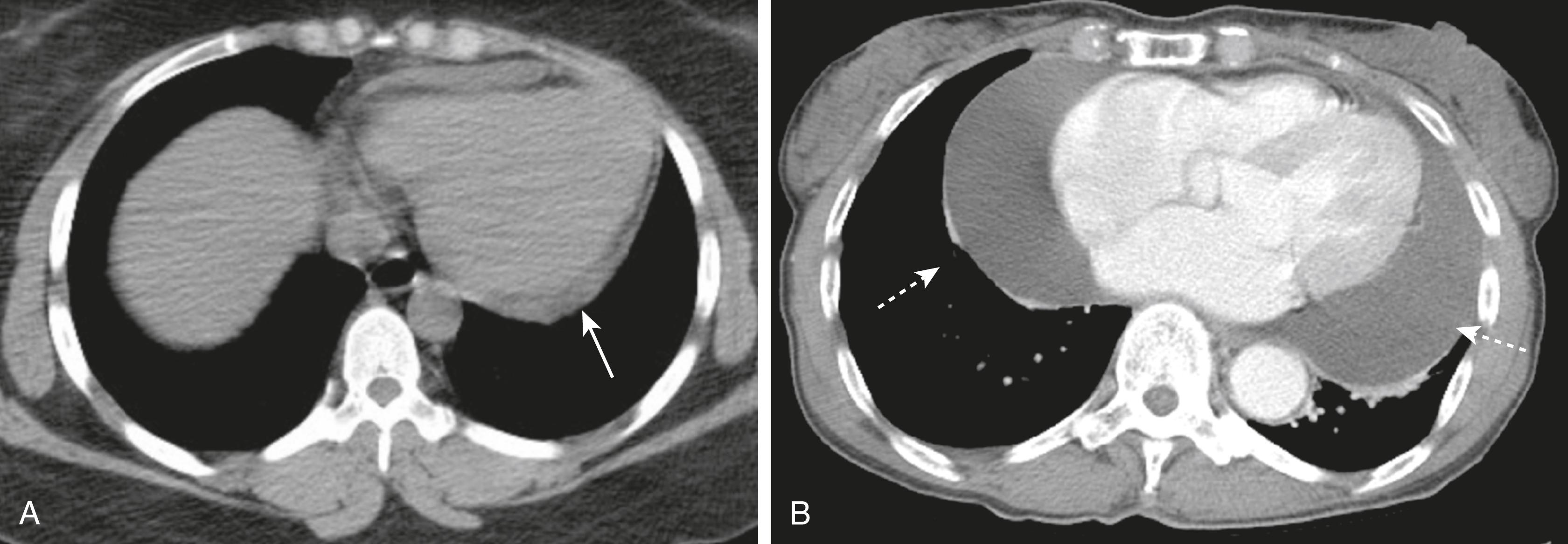
CT scans can demonstrate small pericardial effusions, although pericardial ultrasonography is usually the imaging study of first choice. Conventional radiographs are poor at defining a pericardial effusion.
Some of the causes of pericardial effusions are outlined in Box 11.1 .
Congestive heart failure
Infection (TB, viral)
Metastatic malignancy (especially lung and breast)
Uremic pericarditis
Collagen vascular disease (lupus)
Trauma
Postpericardiotomy syndrome
Sometimes, there is an extracardiac cause of apparent cardiac enlargement on conventional radiography that may cause the cardiothoracic ratio (see Fig. 3.1 ) to appear greater than 50%, while the heart itself may actually be normal in size.
The extracardiac causes of apparent cardiomegaly are outlined in Table 11.1 . Magnification of the heart produced by projection, usually on an antero-posterior (AP), supine, portable chest examination, is the most common cause of apparent cardiomegaly.
| Cause | Reason for Enlarged Appearance |
|---|---|
| AP portable supine chest is the most common cause | Magnification due to AP projection |
| Suboptimal inspiration | In expiration, the diaphragm moves upward and compresses the heart, making the heart appear larger than it would be in full inspiration. If there are eight to nine posterior ribs visible on the frontal chest radiograph, then the inspiration is adequate. |
| Obesity, pregnancy, ascites | These conditions may prevent an adequate inspiration. |
| Pectus excavatum deformity, a congenital deformity of the lowermost section of the sternum, causing it to bow inward and compress the heart | The heart is compressed between the sternum and the spine. |
| Rotation | Especially when it occurs to the patient’s left, rotation may make the heart appear larger (see Fig. 2.2C–H ). |
| Pericardial effusion | Other imaging modalities (most commonly ultrasound), CT, or electrocardiographic findings will help to identify pericardial fluid. |
So, is it possible to estimate the size of the heart on a portable chest radiograph? The answer is “yes.” A good rule of thumb: If the heart appears enlarged on a well-inspired, portable chest radiograph , it probably is enlarged ( Table 11.2 and Fig. 11.2 ).
| Appearance of Heart on AP Study | Likely “Actual” Heart Size |
|---|---|
| Borderline enlarged | Normal size |
| Significantly enlarged | Enlarged |
| Touching, or almost touching, the left lateral chest wall | Definitely enlarged |
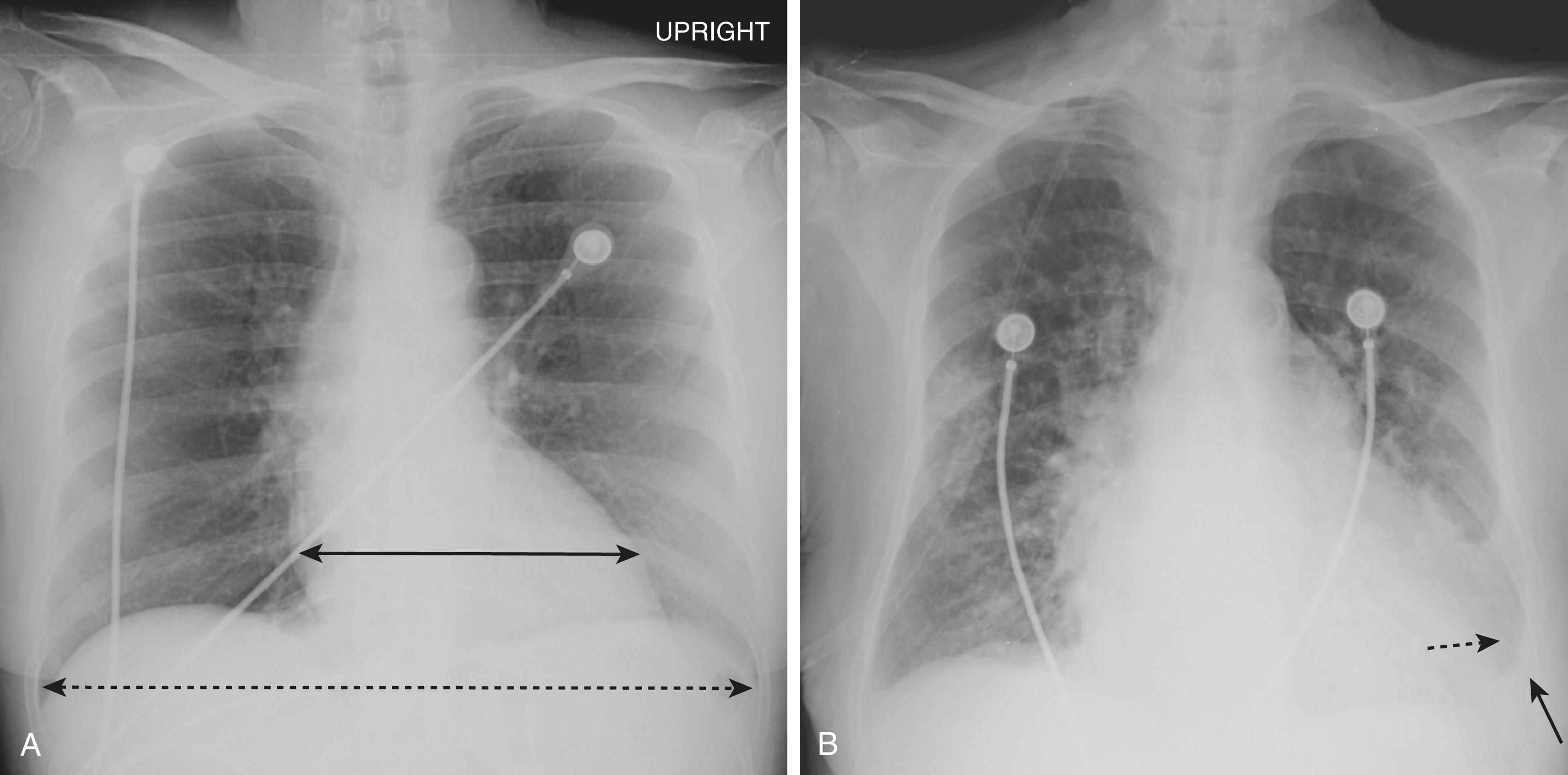
Generally speaking, evaluation of cardiac size using conventional radiography is best made on the frontal chest radiograph. To evaluate for the presence of enlargement of the cardiac silhouette in the lateral projection, look at the space posterior to the heart and anterior to the spine at the level of the diaphragm. In a normal person, the cardiac silhouette will usually not extend posteriorly and project over the spine ( Fig. 11.3A ).
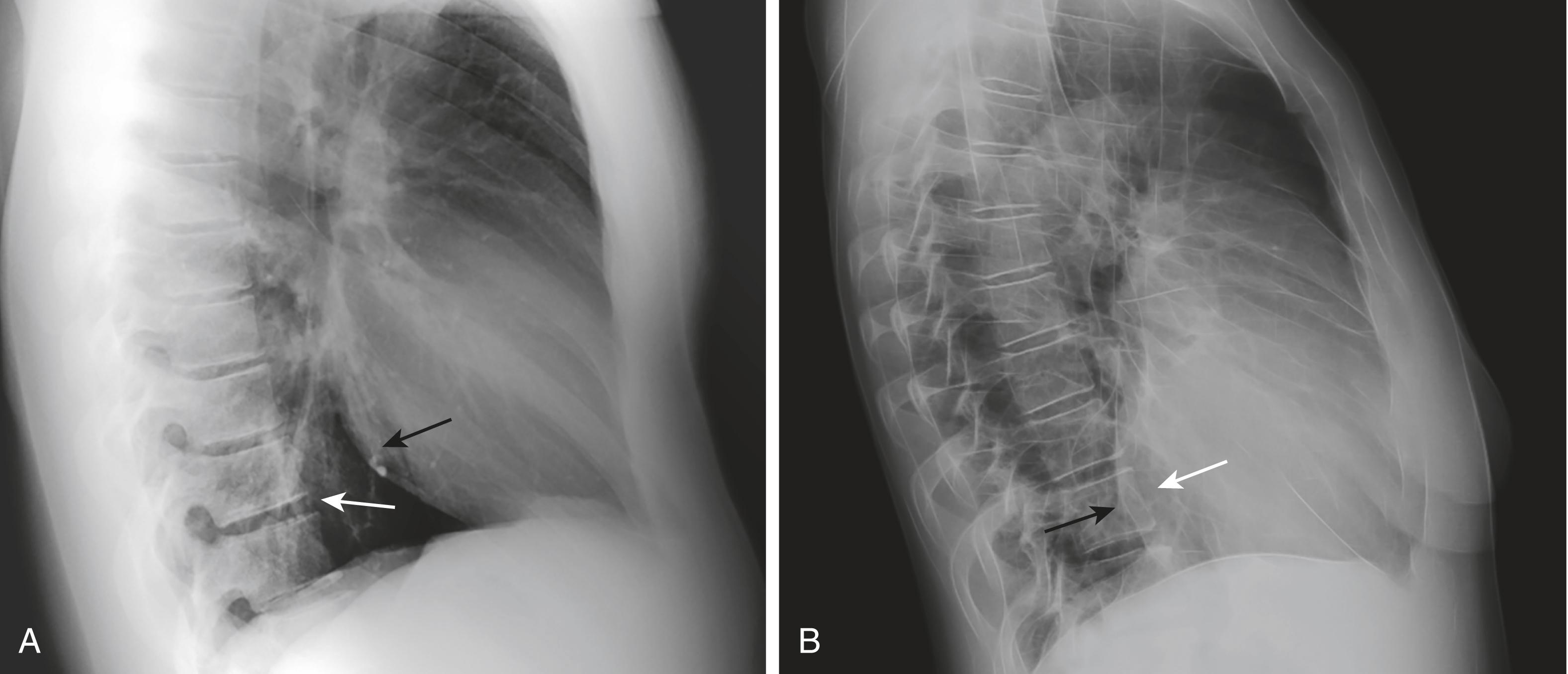
As the cardiac silhouette enlarges , whether that enlargement is due to cardiomegaly or pericardial effusion, the posterior border of the heart may extend to, or overlap, the anterior border of the thoracic spine. This can be useful as a confirmatory sign of an enlarged cardiac silhouette ( Fig. 11.3B ).
In this section, several diseases will be discussed in more detail. Most of them produce abnormalities in size and contour of the heart or great vessels. For a systematic approach to recognizing the cardiac contour abnormalities on chest radiographs in adults, see e-Appendix B. The ABCs of Heart Disease ![]() . The diseases to be discussed here are:
. The diseases to be discussed here are:
Congestive heart failure and pulmonary edema
Cardiogenic versus noncardiogenic pulmonary edema
Hypertensive cardiovascular disease
Mitral stenosis
Pulmonary arterial hypertension
Aortic stenosis
Cardiomyopathy
Thoracic aortic aneurysm and aortic dissection
Coronary artery disease
The incidence of congestive heart failure (CHF) has grown rapidly over the last two decades so that CHF is one of the most common diagnoses in hospitalized patients over the age of 65.
Causes of congestive heart failure
In the United States, the two most common causes of CHF are coronary artery disease and hypertension .
Other causes of CHF:
Cardiomyopathy , such as from long-standing alcohol abuse
Cardiac valvular lesions like aortic stenosis and mitral stenosis
Arrhythmias
Hyperthyroidism
Severe anemia
Left-to-right shunts
Typically, congestive heart failure presents with one of two radiographic patterns : pulmonary interstitial edema or pulmonary alveolar edema. Not every feature of each pattern is always present and there is often overlap between the two patterns.
There are four key radiographic signs of pulmonary interstitial edema :
Thickening of the interlobular septa
Peribronchial cuffing
Fluid in the fissures
Pleural effusions
The interlobular septae are not detectable on a normal chest radiograph but can become visible if they accumulate excessive fluid, usually at a pulmonary (venous) capillary wedge pressure of about 15 mm Hg. The thickened septae are called septal lines or Kerley B lines (named after Peter James Kerley, an Irish neurologist and radiologist).
Recognizing Kerley B lines
Kerley B lines actually do exist. They will be visible on a frontal radiograph usually at the lung bases, at or near the costophrenic angles.
They are very short (1–2 cm long), very thin (about 1 mm), and horizontal in orientation, which means they are perpendicular to the pleural surface.
They usually extend to and abut the pleural surface ( Fig. 11.4 ).
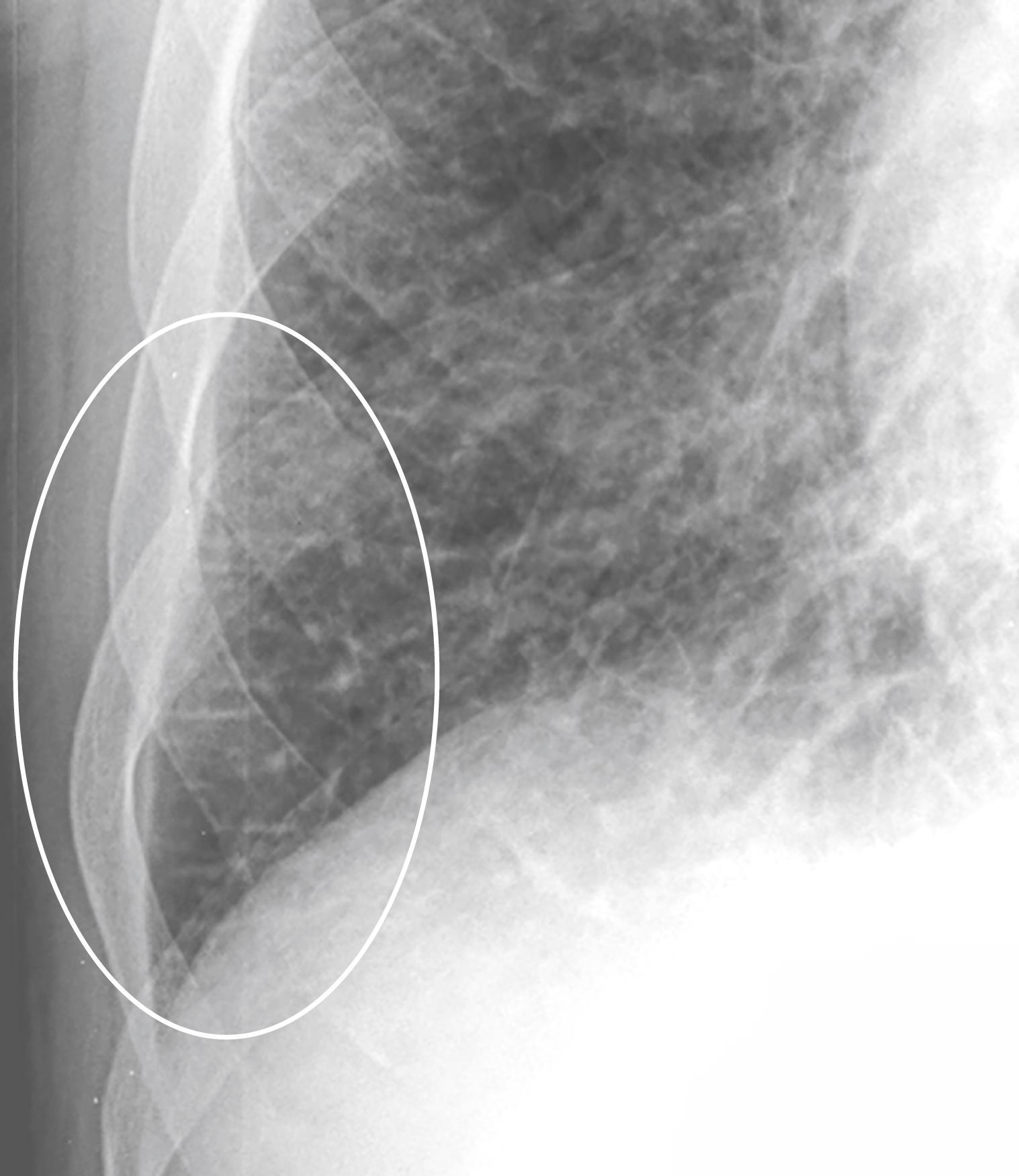
After repeated episodes of pulmonary interstitial edema, the septal lines may fibrose and therefore remain, even after all other signs of pulmonary interstitial edema clear. These are called chronic Kerley B lines and they may be present even if the patient is not clinically in congestive failure.
Kerley A lines
Kerley was busy naming other lines seen in congestive heart failure besides the “B” line.
Kerley A lines appear when connective tissue around the bronchovascular sheaths in the lung distends with fluid. Kerley A lines extend from the hila for several centimeters but do not reach the periphery of the lung like Kerley B lines ( Fig. 11.5 ).
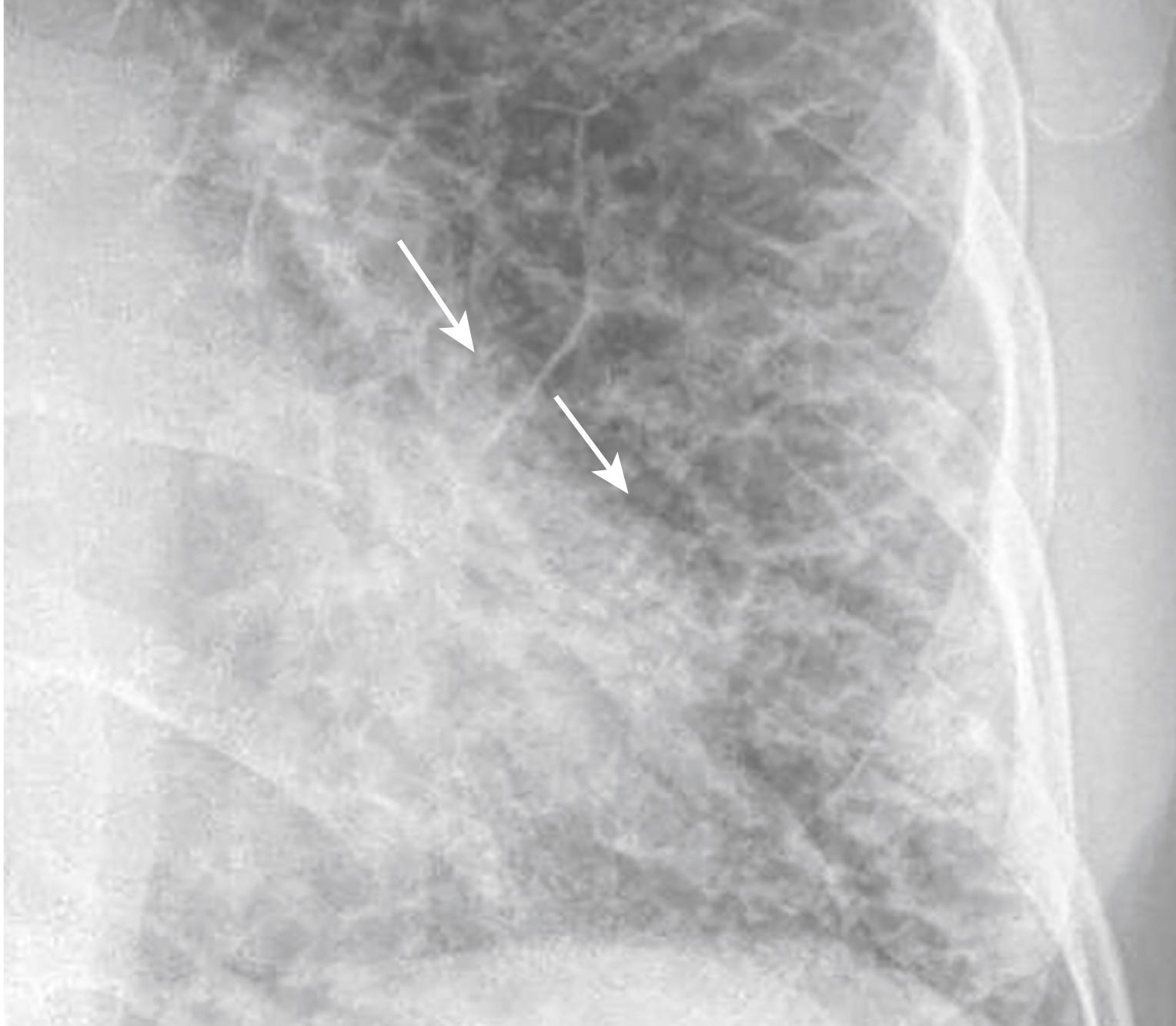
Once he started, Kerley apparently had trouble stopping and he also described “C” lines, but there is some doubt that they exist as separate entities.
Become a Clinical Tree membership for Full access and enjoy Unlimited articles
If you are a member. Log in here